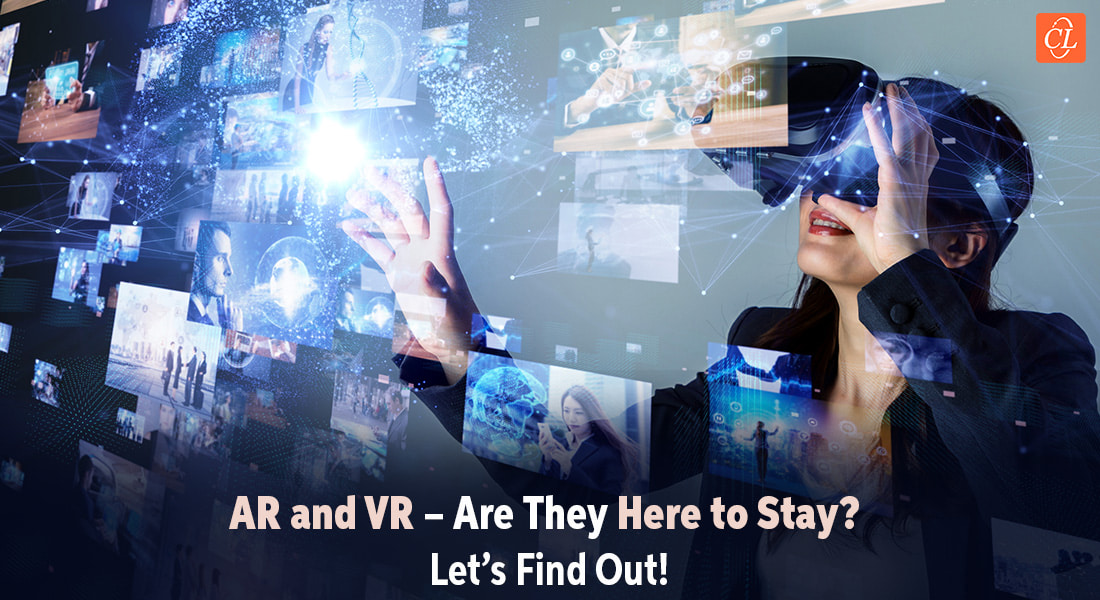AR and VR – A Passing Fad or the Future of Corporate Training?

When it comes to corporate training, there is no one-size-fits-all solution. Companies have recently found that augmented reality (AR) and virtual reality (VR) are the perfect tools to engage and educate their employees. Others, however, find that these technologies are nothing more than a passing fad.
A study in 2020 suggested that immersive technologies, such as AR, VR, XR (extended reality), and MR (mixed reality), are useful for several educational purposes. 66% believed that by 2022, these technologies would revolutionize immersive teaching, 57% suggested it can be useful for developing soft skills, while only 26% were confident that they could help with self-directed learning
Wondering How AR & VR Help eLearning and Corporate Training?
Take a look at some of the advantages of AR & VR:
- Allows employees to practice in a realistic and safe environment
- Creates custom training programs that are specific to organizational needs and potential risks
- Uses the technology to teach and develop soft skills
- Helps in increasing the training ROI over time
One of the most important elements when determining the technology’s viability for the future is to carefully consider the industry’s (especially the learners’) needs and objectives. Do you believe that AR and VR can help your company achieve its goals? In this article, we will take a closer look at AR and VR technologies for eLearning to see if it is a passing trend or if the tech is here to stay.
AR & VR For eLearning & Corporate Training
There are several advantages that AR and VR can offer for corporate training. These technologies can create an immersive learning experience that allows employees to practice skills in a safe and realistic environment. Additionally, AR and VR can be used to create custom training programs that are specific to your company’s needs.
Of course, AR and VR are not without their disadvantages. These technologies can be expensive to implement, and there is always the risk that employees will find them gimmicky or unnecessary. Additionally, some employees may feel uncomfortable with the idea of being fully immersed in a virtual environment.
These disadvantages are why the trend isn’t really sticking, and training managers are still on the fence about the technology.
Do you wish to be an eLearning champion and scale your corporate training to new heights? Access this free webinar recording for actionable insights.
How AR is Being Used for Corporate Training & eLearning
Artificial Reality can be used in several different ways to support corporate training and eLearning. For example, AR can be used to create immersive learning experiences that allow employees to practice skills in the environment they are in. This technology has been used extensively to develop soft skills.
AR has also been used to create custom training programs that are specific to your company’s needs. Walmart, for example, is using AR to train its employees on how to operate new equipment. And Boeing is using AR to teach engineers how to assemble aircraft parts.
How VR is Being Used for Corporate Training & eLearning
Like AR, Virtual Reality can be used in a few different ways to support corporate training and eLearning. Currently, VR is more common than AR, especially for corporate training or for skill development, because it can completely transform one’s environment and give more “experience-oriented” training.
The eLearning industry has been using VR more, as well. However, when it comes to corporate training, depending on the subject, VR may not be as useful. This is because, in many instances, the environment needs to be the same for employees, and they must react to mental triggers in said environment.
Military training, on the other hand, benefits quite extensively from VR because of the versatile environment. NASA, the Marine Corps, Airforce, and more have used the technology extensively for eLearning and to give operators a better idea about what they can expect in the real world.
For corporate training, VR is mostly used to create custom interactive training programs that employ five of the six senses (all except touch) to create psychological triggers and train responses. This has helped train managers from functional and structural brain memory to train cognitive responses accordingly.
However, such extensive training is a rarity in the corporate sector, not the norm.
Ultimately, it is up to the training manager and the company itself to decide whether AR and VR are right for their corporate training and eLearning needs. The most important element to consider is the topic of the course and whether it warrants a response by all six senses (or five) or if the response requires the right mental capacity.
How AR & VR Are Devising Better Corporate Training & eLearning Courses
As technologies like augmented reality (AR) and virtual reality (VR) continue to evolve, more and more companies are beginning to experiment with these new tools for corporate training and eLearning. AR and VR offer a few advantages that can help employees learn new skills more efficiently and effectively.
For example, by creating immersive learning experiences, AR & VR allow employees to practice skills in a safe and realistic environment. Additionally, AR and VR are being used to create custom training programs that are specific to organizational needs and potential risks.
AR & VR for Soft or Hard Skills
Both AR and VR have their own unique uses and can therefore be used for soft and hard skills alike. The ultimately determinant for the skill it develops depends on the design and content of the course. Naturally, developing and authoring AR and VR eLearning courses is much more difficult and may not always be cost-effective.
While the technology can be used for developing soft skills as well as hard skills, it may not always be cost-effective for the former. This is because there are several techniques that you, as a training manager, can adopt to teach and develop soft skills.
Furthermore, instances where soft skills are needed, may vary too much to be developed by VR and AR. Considering how much it costs and the time it takes to develop these eLearning and corporate training courses, for soft skills, these courses may be used once or twice at most.
Hard skills, on the other hand, require a more hands-on approach, and therefore, AR and VR courses are more suited for this. Consider the example of how the technology can be used to train pilots. Even if retaking the course may mean that procedural memories may kick in, the adage “practice makes perfect” comes into play here.
Today’s modern authoring tools help create courses with AR and VR and since these courses have enhanced utility, they help in increasing the training ROI over time.
Is AR & VR Here to Stay for eLearning & Corporate Training?
AR and VR technology is still in its early stages, and it remains to be seen how well it will be embraced by the corporate world. That said, there are several advantages that these technologies can offer for corporate training and eLearning.
Furthermore, AR and VR have proven to be more effective for hard skill training than soft skills, but there have been several breakthroughs in soft-skill training as well. Currently, the only issue that remains is that of cost balancing for the latter, though. The industry is looking to implement AR and VR to develop five key soft skills via eLearning. These include:
- Customer service (VR)
- Presentation and communication skills (AR and VR)
- Employee evaluation (AR)
- Feedback implementation (AR and VR)
- Senior leadership (VR)
Parting Thoughts
It is quite possible that over time, we’ll see more and more companies using AR and VR for soft and hard skill development because of such studies, especially as the world finds more cost and time-effective solutions for these eLearning and corporate training modules.
Along with AR and VR, there are many new cool concepts that are making their place in the corporate training landscape. If you are eager to know about what’s trending in the present-day corporate world, take a look at this eBook to catch a glimpse of the latest eLearning trends.



![6 Ways to Use Virtual Training for Employee Training [Slideshare]](https://blog.commlabindia.com/hubfs/Imported_Blog_Media/corporate-training-virtual-training-methods-slideshare.jpg)

